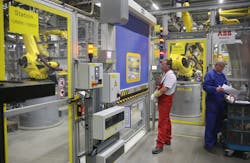The debate around automation technologies eliminating jobs has been going on for decades—for centuries, one could argue if the discussion is framed more generally around the impact of technology on jobs.
In all of these discussions recently, there’s been no shortage of data to show that, in fact, technology does indeed eliminate a portion of existing jobs. In some cases, this elimination occurs during a short period of time; in other cases, it takes place over decades.
There also typically exists a corresponding amount of data highlighting all the new jobs and industries created by the very technologies that eliminated or changed the previously existing jobs. These data often show that, over time at least, the new technology tends to be a net creator of jobs, i.e., more jobs are produced by the new technology introduction than are lost.
The main takeaway, of course, is that the impact of advancing technology on jobs is not a zero-sum equation (as I wrote in this blog post last year). Given that, the principal question before us is not whether automation (or any technological advance) is good or bad for jobs—if human history has shown us anything it’s that technological progress is inexorable. The question is: Can we handle the transition better than we have in the past?
This question becomes more important when you consider the speed at which new, disruptive technologies are being introduced and embraced by industries of all types. That’s at the core of what we’re really talking about today when we talk about automation taking away jobs.
After all, evidence of technologies eliminating jobs and even entire industries is plentiful. What makes today different is the speed at which this now occurs.
With respect to current industrial automation technologies, as well as the growing use of artificial intelligence (AI) in conjunction with automation, the “Automation and Artificial Intelligence” report from the Brookings Institution suggests that answering this question is best approached by looking first at the jobs most at risk of being impacted by automation. Examining the potential for automation and average wage of each job type, the Brookings Institution’s report highlights the industries, job types and people most likely to be impacted by automation in the near term.
For example, the occupations with the highest potential of being impacted by automation and AI are packaging and filling machine operators and tenders (100 percent automation potential) and food preparation workers (91 percent). Conversely, the jobs with lowest potential impact from automation and AI are home health aides (11 percent), software developers (8 percent), and management analysts (4 percent).
Essentially, the threat automation poses to a job boils down to the tasks required by that job. Routine, predictable and repeatable tasks are at the highest risk of automation. Tasks that require creativity, analysis and response to unpredictability are at the lowest risk of being automated.
With the most susceptible jobs identified, the next question is: How fast will this transition occur?
In the Brookings report, data from McKinsey predicts that the “technical automation potential makes major strides by 2030, with full potential being achieved as early as 2040 or as late as 2050.” Based on an array of factors considered by McKinsey, the report notes that full adoption could occur as late 2065, rather than 2050 or 2040.
Though some of these dates might seem distant, the reality is that we need to begin preparing for “major strides” in automation’s impact on employment to begin being felt by 2030—just a little more than a decade from now.
Fortunately, at least two models exist—one privately funded and one publicly funded—to help guide our approach in dealing with this.
In a McKinsey podcast, “What Can History Teach Us About Technology and Jobs?” Susan Lund of the McKinsey Global Institutereferenced two similar, yet different, models currently being deployed in Sweden and Germany to deal with this very issue.
“In Sweden, the worker-security councils are a system in which employers pay a small amount per worker into a private fund so that if the company downsizes and a worker is laid off, that individual goes to the worker-security council and they get a whole suite of services,” Lund said. “And this is all privately run ... It goes beyond simply providing income support to actually helping individuals find their next job.”
Lund noted Germany’s “very successful government-run system that operates in many ways very similarly [to the Swedish worker-security council]. Reforms that were implemented in the early 2000s, the so-called Hartz reforms, have enabled Germany to reduce what was a relatively high unemployment rate, over 11 percent, down to about 3.5 percent today.”
Lund contends that, in both cases, “there’s a lesson that mid-career people can find new occupations and new jobs.” Her one caveat to this is the case of rapid automation adoption. In other words, if jobs are automated more rapidly than McKinsey predicts, “it’s going to take a more comprehensive and organized approach in many countries than we’ve seen so far,” Lund said.
The Brookings Institution report also highlights Denmark’s “Flexicurity” system which combines intensive support for workers with “a duty to work.”
Considering the high levels of advanced automation technologies clearly coming our way, it’s past time for us to critically examine how to manage the coming technological transition. Automation and other technological advances that impact jobs can't be avoided. Proposing to do so runs counter to human history and human nature.
Helping people adapt is the only way to avoid—or at least minimize—the negative economic and societal impacts that will affect us all if nothing is done. How we choose to do it is the question.
Leaders relevant to this article:


